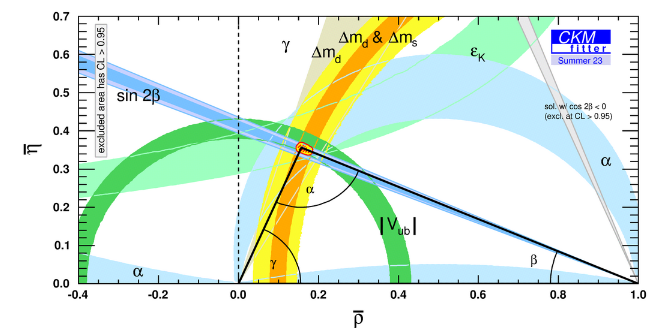Today, at the 42nd International Conference on High Energy Physics, ICHEP, Prague, Czech Republic, the LHCb collaboration reported an improved determination of the CKM angle γ with a precision better than 3°. This result was obtained by a simultaneous combination of measurements sensitive to the CP-violating angle γ of the Cabibbo-Kobayashi-Maskawa (CKM) unitarity triangle, to the charm parameters describing oscillations between D0 and D0 mesons and to the CP asymmetries in charm decays (see this 2021 publication for technical details of the combination).

LHCb is an experiment designed to study the physics phenomenon called “CP violation”, that is strictly related to the disappearance of antimatter soon after the Big Bang allowing only matter to survive and build the universe we live in today. To do this, LHCb physicists measure differences between the properties of matter and antimatter particles, due to the presence of CP violation. CP violation was discovered experimentally in 1964 in the decay of neutral K mesons. In 1973, M. Kobayashi and T. Maskawa proposed a mechanism that could incorporate CP violation into the theory that years later would have become known as the Standard Model of Particle Physics (SM), predicting the existence of at least 3 families of particles; they were awarded the 2008 Nobel Prize in Physics for this idea. The size of CP violation in the SM is set by the parameter η, shown as the y-axis in the figure above. Constraints on η and the related parameter ρ (the x-axis) are measured in various ways in different experiments as shown in the compilation made by the CKMfitter group in the figure. The constraints show that in fact the values of ρ and η within the small coloured region in the centre of the figure are indeed compatible with the experimental results, thus confirming the Kobayashi and Maskawa SM mechanism of CP violation. However, as this mechanism does not explain the large amount of matter observed in the universe physicists are looking for other sources of CP violation beyond the SM.
An important measurement in this context is that of the angle γ of the CKM unitarity triangle, checking whether the value of the angle γ is compatible with the intersection of all the other constraints. Any disagreement about where to place the apex of the unitarity triangle in the above figure would be a sign of new physics. Measuring the angle γ in different processes is one main goals of the LHCb experiment.
The lower left image shows the angle γ determination for different B meson decay modes and the lower right image shows the same determination for different decay-time dependencies.
The angle γ is found to be (64.6 ± 2.8)°, which is the most precise determination from direct measurements to date. The CKM unitarity triangle can also be also be determined without using the direct experimental measurements of the angle γ and in this way an indirect prediction can be obtained to be (66.3+0.7-1.9)°, as derived by the CKMfitter group. Another indirect prediction obtained by the UTfit group using a different statistical method is (65.2±1.5)°. The difference between direct and indirect determination could indicate the presence of new physics, and today’s more precise LHCb measurements test the SM with higher precision than before. Future LHCb measurements with a larger data sample, to be obtained with an upgraded detector, will allow the precision of the indirect determination to be reached.
Read more in the LHCb presentation and in the conference note.


